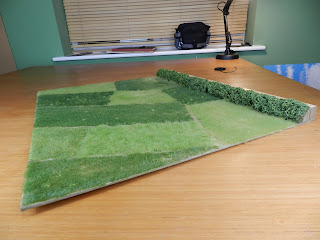Having got myself a half-decent camera, I decided to build a board with a ground surface and sky backdrop, on which I could place models to photograph. My idea was that the "sky" would be on a board which would stand up in a slot at the back and the join would be hidden by a line of bushes. Like a lot of our projects, this took a good deal longer to realise than expected. But here it is at any rate. We'll very shortly have some pictures of the Russian buildings I have since photographed on it.
Here's the board, which is built on a sheet of hardboard, first covered with filler plus a bit of PVA, covered in sand and grit and then painted and drybrushed to give some impression of earth. I wanted to get the impression of the "patchwork" of crops that was typical of the pre-modern battlefield. You can see the board curled up a little at the front corners, though that won't show on the finished photos.
Now from a low angle. I covered it with static grass in different colours, different mixes and using different methods. I'm not a big fan of expensive tools, but I did treat myself to a "Super Power Grass Applicator" from the Italian firm of Diorama Presepe (link added to my list). It set me back about £120, but it's certainly powerful ( 40volts) and rather satisfying, so long as you don't mind the odd little electric shock from the powerful build-up of static electricity.
The slot, made from two battens screwed to the hardboard. It's concealed by bushes made from rubberised horsehair. I was learning the knack of using static grass here. Some fields came out nicer than others, such as the nearest one came out with its nice blend between colours.
Here you can see what the whole thing look like with a sky backdrop slotted in. I tried to paint a nice new sky, but when I found you could buy one for the purpose for only a few pounds it seemed a better option. The downside of buying the cheapest one though is that it has to find its way here from China (via slow boat it seems), so I'm temporarily having to use my old sky board from 1989.
Now from a low angle with suitable cropping of the photo, you get the picture of how it's supposed to look. The main thing with using long static grass and a powerful applicator is that it looks realistic and pleasingly lush. I modelled some flowers growing in the fields but kept it very low key because garish clumps can ruin the natural effect.
I planned to use a line of trees to further blur the join between board and backdrop, but I'm not sure it adds much in practice. The bases stand out because of the "dead leaf" covering, and we see the downside of tall static grass as a board covering: bases placed on top "float" a few millimetres above the actual board rather than blending in, certainly when viewed from this low angle. Figure bases would presumably do the same. It might not be so noticeable from the normal angle as we sit or stand well above the board.









Very nice and effective.
ReplyDeleteYou have certainly put a lot more effort in than I did John! For taking pics of my painted figures, I just took some 2/3mm card, cut into four - a base, a back board and two side - glued them together (they are coming apart now!) used several different coloured pieces of felt for the "grass" and printed off about 50 different backgrounds from various images on Google - fields, trees, Scottish castles, interiors of stately homes etc - depends on what the figures are, which ones I use - when I was painting western gunfighter figures, I printed off a few Wild West town scenes when it was 20mm "War on Terror" stuff, I did some images from Afghanistan circa 2010!
ReplyDeleteSimple but very effective John. If I had somewhere to keep it I might have a go at making one. I have a small board I could use and them just make the sky backdrop, which would probably be fine. Something else to add to the list!
ReplyDeleteGreat idea and thank you for explaining how you made it.
ReplyDeleteThanks very much, everyone. This is only one way to get a useable backdrop, and your approach sounds great, rross.
ReplyDelete